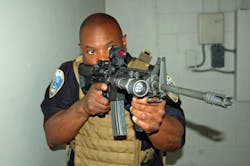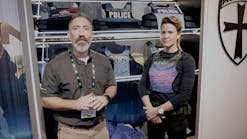In the March 2013 report United States Active Shooter Events from 2000 to 2010: Training and Equipment Implications, written by J. Pete Blair and M. Hunter Martaindale of the Advanced Law Enforcement Rapid Response Training (ALERRT) of Texas State Univesity, several different suggestions are submitted.
Research findings from that study:
- 84 Active Shooter Events (ASEs) occurred between 2000 and 1010
- The frequency of ASEs appears to be increasing
- Business locations were the most frequently attacked (37%), followed by schools (34%), and public (outdoor) venues
- The median number of people killed during ASEs is 2. The median number of people shot is 4
- The most commonly used weapon was a pistol (60%), followed by rifles (27%), and shotguns (10%)
- Attackers carried multiple weapons in 41% of the attacks
- Body armor was worn in 4% of cases
- Improvised Explosive Devices (IEDs) were brought to the scene in 2% of cases
- Some shooters attempted to deny police access to the attack site through the use of barricades
- The attacks ended before the police arrived 49% of the time. In 56% of the attacks that were still ongoing when the police arrived, the police had to use force to stop the killing
- EMS entry to the attack site is often delayed because the police must conduct a thorough search of the scene in order to declare it secure
Some Training Implications (partial list):
- Expect a fight – Training must not assume that the attacker will be dead or give-up without resistance
- Medical – Officers should be provided with training that will allow them to stabilize victims long enough for either EMD to enter the scene or for officers to transport victims to the EMS casualty collection point
Equipment recommendations:
- Medical – Officers should be issued the equipment they need to provide immediate lifesaving aid
- Harm Body Armor – Officers should be issued plate carriers to increase their survivability
- Patrol Rifles – Officers should be equipped with rifles to allow them to more effectively resolve ASEs
Nothing Earth shaking here that we note. Most law enforcement survival authorities and trainers, including yours truly, have recommended an aggressive response to an active killer. Frequently police officers actively hunting for the perpetrator will drive him to commit suicide (thus solving the problem) if the LE officers don’t neutralize the threat on their own. In pursuit of this aggressive response, well-trained carbine equipped officers can be more accurate and effective on target with 5.56 carbines. Recommendations for carrying a CAT – Combat Applications Tourniquet, Israeli battlefield dressing or a hemostatic bandage such as Quick Clot® as well as increased training in combat first-aid have proven lifesavers for military personnel and have filtered over into civilian police work.
But hard body armor or plates capable of stopping rifle fire from active killers? Actually the notion makes perfect sense.
Threat Levels of Armor
Most police body armor whether concealed beneath the duty shirt or outside the shirt in one of the popular external carriers is Level IIA. According to the National Institute of Justice, Ballistic Resistance of Body Armor; NIJ Standard-0101.06, published in July of 2008, Level IIA is designed to stop 9mm and .40 S&W handgun rounds.
Level II is a heavier vest and is rated to stop higher velocity 9mm rounds and .357 Magnum handgun bullets.
Type IIIA armor is rated for the even faster .357 SIG and .44 Magnum rounds. Because of the weight and thickness of Type IIIA it is usually worn as an external vest by SWAT or tactical teams.
Type III is rated for rifles and can be a conjunction design to be worn in addition to soft body or a plate or armor that can withstand 7.62 X 52mm (.308 Winchester).
Type IV armor has been certified by the NIJ to withstand .30 caliber, armor piercing rounds. This can be a stand-alone plate or a conjunction design.
So, to be clear, most vests as worn by street police officers in the United States isn't sufficient to stop a rifle round such as the 7.62 X 39mm fired from an AK47. And since according to Blair/Martaindale research cited earlier, 27% of Active Shooters may be carrying arms/ammo that can easily penetrate an officer’s body armor, it's a concern we need to address.
I’d say the case is pretty clear for the option to don Level III plate carriers when heading into an Active Shooter (I prefer the term active killer) encounter. Since the potential for your standard garden variety violent thug to possibly be armed with an AK or a .30 cal or above rifle, the need for rifle plate carriers in multiple armed encounter situations exists.
Tacprogear Active Shooter Defense Kit
Tacprogear out of Delray, Florida and manufacturer of bags, packs, holsters, belts, slings, pouches & police duty gear as well as all things nylon for police, military, EMS and military contractors, recently sent me an Active Shooter Defense Kit for T&E.
The kit includes the well designed Tacprogear Rapid Assault Plate Carrier. The plate carrier, which I ordered in Coyote Tan can carry front and rear 10” X 12” armored plates. Manufactured from 1000 denier nylon. The front of the carrier features a large pocket with an access zipper on either side for ambidextrous use. The inside of this pocket features Velcro allowing for a handgun holster to be affixed. With padding at the shoulders the interior of the carrier panels feature a mesh material to improve air flow. A drag strap is located at upper edge of the rear panel as well.
The two Ballistic Ceramic plates are Level IV stand-alone which gives the wearer center mass protection for .30 armor piercing rifle rounds.
Donning and adjusting the Rapid Assault Plate Carrier was relatively easy. Once the shoulder panels are adjusted one side of carrier can be buckled thus requiring that you only have to insert an arm, buckle the other side and you’re good to go. The design of the carrier allows placement so that the carbine butt-stock can be properly seated in the pectoral area.
Both Level IV stand-alone plates and carrier weigh in at 15 pounds. Of course, once you add a magazine carrier to the MOLLE you’re going to increase weight but I suspect that the weight will vanish when/if the bullets start flying in your direction. MSRP for the Tacprogear Active Shooter Defense Kit is $379.99.
Wrap-Up
Hyper-violent subjects including Active Shooter/Killers as well as hardened street criminals are a fact that we have to plan and train for. Going into an active killer event armed only with a standard duty pistol while wearing only Level IIA armor seems risky. Improve your odds, train like your life depends on it, roll with a 5.56 carbine with adequate ammunition and don a Tacprogear armored carrier. Your life is worth it!
United States Active Shooter Events from 2000 to 2010: Training and Equipment Implications; by Blair and Martaindale
www.alerrt.org/files/research/ActiveShooterEvents.pdf
Active Shooter Events and Response (book) from Amazon.com by Blair, Nichols, Burns, Curnutt
Tacprogear Website for Active Shooter Defense Kit

Kevin Davis | Tactical Survival Contributor
Kevin R. Davis retired from the Akron Police Department after 31 years with a total of 39 years in law enforcement. Kevin was a street patrol officer, narcotics detective, full-time use of force, suspect control, and firearms instructor, and detective assigned to the Body Worn Camera Unit. Kevin is the author of Use of Force Investigations: A Manual for Law Enforcement, and is an active consultant and expert witness on use of force incidents. Kevin's website is https://kd-forcetraining.com/



